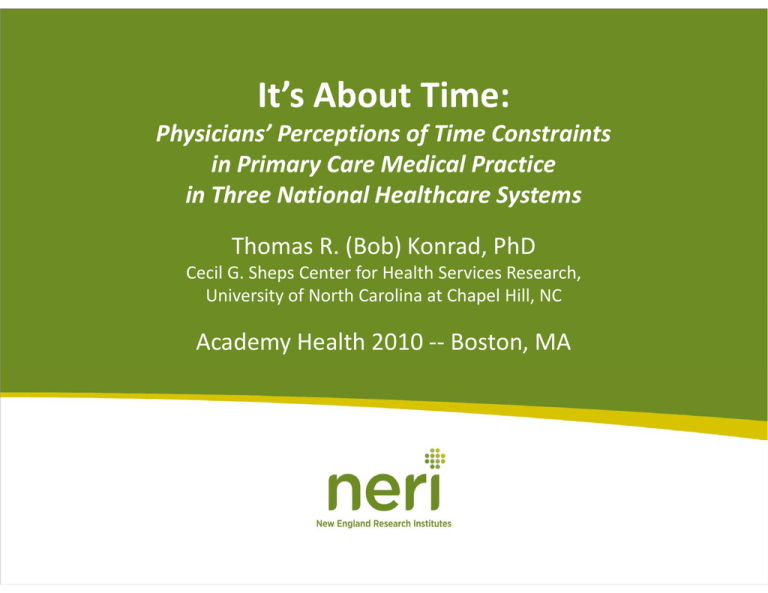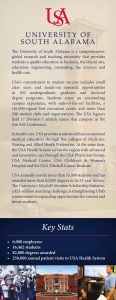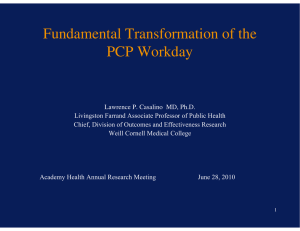It’s About Time:
advertisement

It’s About Time: Physicians’ Perceptions of Time Constraints in Primary Care Medical Practice in Three National Healthcare Systems Thomas R. (Bob) Konrad, PhD Cecil G. Sheps Center for Health Services Research, University of North Carolina at Chapel Hill NC University of North Carolina at Chapel Hill, NC Academy Health 2010 ‐‐ Boston, MA Background • Physicians increasingly work in managerially driven Physicians increasingly work in managerially driven organizations/systems where they are pressured to: • deliver an increasing number of preventive services, de e a c eas g u be o p e e t e se ces, • follow guidelines, engage in evidence‐ based practice • deliver “patient‐centered” care in a “medical home” • They struggle with how much control they have over their time: • Hours of service , office schedule. • Minutes of patient contact Time matters everywhere Time matters, everywhere • A recent systematic review found longer physician visits associated with: • • • • • more attention to psychosocial problems, lower prescribing rates, better quality prescribing, lower referral rates, lower return consultation rates, patient satisfaction indicators reflecting “patient‐centeredness” and “enablement.” Longer visits may decrease malpractice litigation risk • Attempts to measure actual visit length have yielded mixed results p g y • • • • Some suggest that US visits became longer up through the mid‐1990s. Mechanic calculated 1998 visit length at 21.5 min using AMA SMS data and 18.3 min using NAMCS data with primary care visits for established patients Gilchrist replicated NAMCS methodology (N=30 family physicians ) found 16.5 min (SE=0.66), but her nurses using a stopwatch clocked averages of 12.8u min (SE=0.52): a 29% overestimate UK studies find considerably shorter visits, typically 10 minutes. • Lack of control over time a factor in 2006 German physician general strike. k f l f h l k Research Questions Research Questions • Does the physician “time crunch” differ across the different health care systems? different health care systems? • How do physicians evaluate and adjust to the time crunch? h? • Does time pressure and control over time differ by physician gender and level of experience? Methods • A secondary analysis of an experimental design A secondary analysis of an experimental design • Video vignettes presented to practicing generalists • Actor patients presenting with symptoms suggesting coronary heart disease or depression. h di d i • Questions on time asked after the video vignettes of actor patients • Data from 3 parallel studies of clinical decision making • • • • Germany, United Kingdom, United States 128 generalist physicians per country. In each country there were 4 equal strata by gender and level of experience Response rates 60‐65% in each country Response rates 60‐65% in each country Measurement • Physicians self‐reported time allocated y p • • • New patient appointments, Routine consultations Complete physicals Complete physicals. • Self‐reported time needed to “provide quality patient care” • • • New patient appointments, Routine consultations Complete physicals. • Physicians reported how much control they had over: Physicians reported how much control they had over: • • their time in the office spending adequate time with patients. Results Mean time allocation in minutes by country: Mean time allocation in minutes by country: Minutes allocated minutes required Type of Visit Germany UK USA New Patient 16.320.8 10.715.7 32.437.9 Routine Visit 5.56.7 9.712.6 18.120.6 Complete Physical 12.514.8 19.825.4 35.941.0 ….for a new patient visit for a new patient visit …for a routine patient visit for a routine patient visit …for a complete physical for a complete physical “Time Time stress stress” in minutes by country: in minutes by country: = minutes required – minutes allocated Type of Visit New Patient Routine Visit Complete Physical Germany UK USA 4.5 4.9 5.5 1.2 3.0 2.5 22 2.2 53 5.3 50 5.0 …more time needed for all types of visits more time needed for all types of visits Physicians’ rating of the extent of control over Spending sufficient time with patients Spending sufficient time with patients US 13 54 30 3 Always U ll Usually UK 3 39 44 14 Sometimes Never Germany 21 52 Comparisons: UK < Germany (p=0.0001) UK < US (p=0.00001) US = Germany (p=0.2956 ) 23 3 Physicians’ rating of the extent of control over the hours they are required to be in their office the hours they are required to be in their office 23 US 43 41 18 0% 38 46 UK 3 Germany 31 20% 40% 30 60% Comparisons: UK < Germany (p=0.0007 ) UK < US (p=0.00001) US = Germany (p=0.2064 ) 8 Always 8 Usually 11 80% 100% Sometimes Never Conclusions Conclusions • US physicians reported greater amounts of time scheduled with patients for all 3 types of visits than do their counterparts in either the UK or Germany. • US US physicians are tied with their German colleagues in their perceptions of ph sicians are tied ith their German colleag es in their perceptions of control over their time, while UK physicians experienced less control on these dimensions. • Results of analyses by gender and level of experience were intriguing, inconsistent and inconclusive inconsistent, and inconclusive. Implications • Time constraints– both actual and perceived – remain important themes in primary care practices across countries and health systems • Time stress could be reduced in several ways: e st ess cou d be educed se e a ays • • • Lengthening scheduled visit times, OR Shortening ideal visit times (more frequent recalls, use of phone or e‐mail, or ancillary personnel) Both methods for different subgroups of patients • Studies examining the impact of “time stress” on physician performance g p p y p and patient outcomes may be useful. • Time Time stress measurement may be a tool that is useful for comparative stress measurement may be a tool that is useful for comparative health system research and for evaluating interventions aimed at improving health systems both at the micro and macro level. Co Investigators Co‐Investigators • United States New England Research Institutes, Watertown, MA g , , • Carol L. Link, PhD, • Rebecca J. Shackelton, ScM, • Lisa D. Marceau, MPH, Lisa D. Marceau, MPH, • John B. McKinlay, PhD • Germany Department of Medical Sociology University of Hamburg Hamburg Department of Medical Sociology, University of Hamburg, Hamburg • Olaf von dem Knesebeck, PhD Institute for Medical Sociology, Heinrich Heine University, Duseldorf • Johannes Siegrist, PhD Johannes Siegrist PhD • United Kingdom Centre for Research on Aging and Gender, University of Surrey, Guildford, Surrey • Sara Arber, PhD Sara Arber PhD Warwick Medical School, University of Warwick, Coventry • Ann Adams, PhD Konrad TR, Marceau L, Link C, Shackleton Konrad TR Marceau L Link C Shackleton R, Arber S, von dem R Arber S von dem Knesebeck O, Siegrist J, Adams A, McKinlay JB. It’s about time: Physicians’ perceptions of time constraints in primary care medical practice in three nations Medical Care 2010 (Feb) medical practice in three nations. Medical Care, 2010 (Feb) 48:95‐100. plus digital appendix. More about this and similar studies visit: neriscience.com More about this and similar studies visit: S Supported by National Institutes of Health, t d b N ti l I tit t f H lth National Institute on Aging: AG16747.






